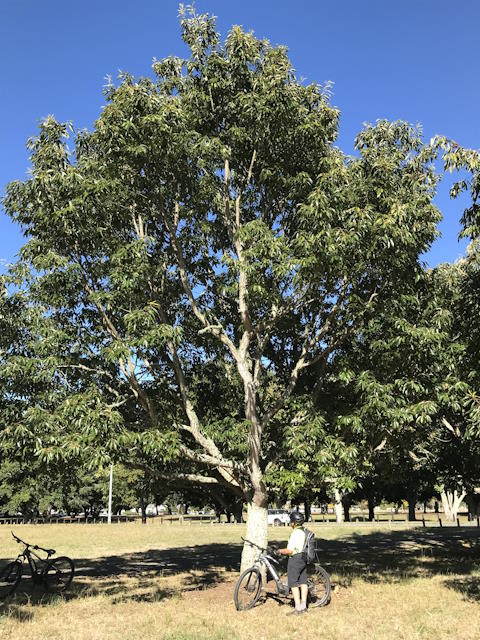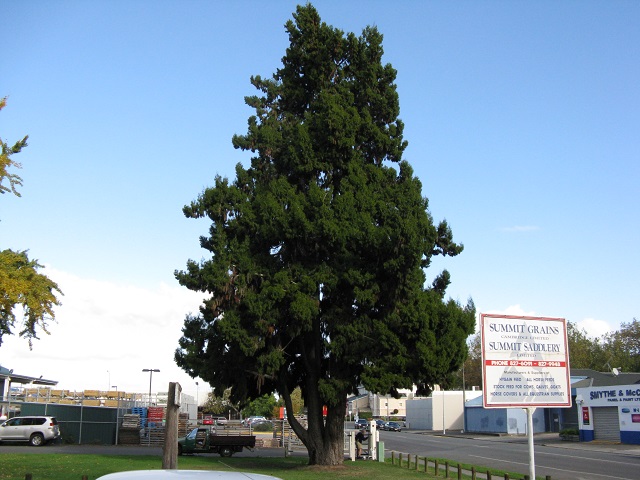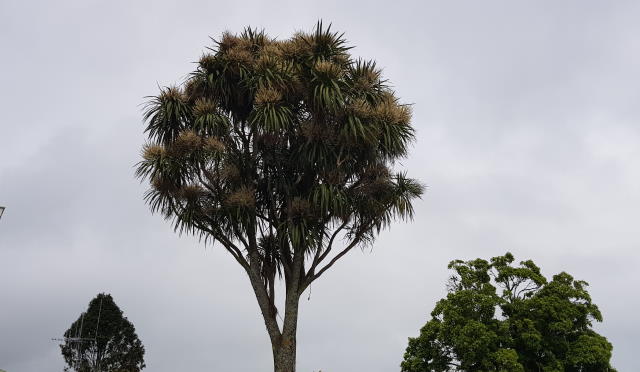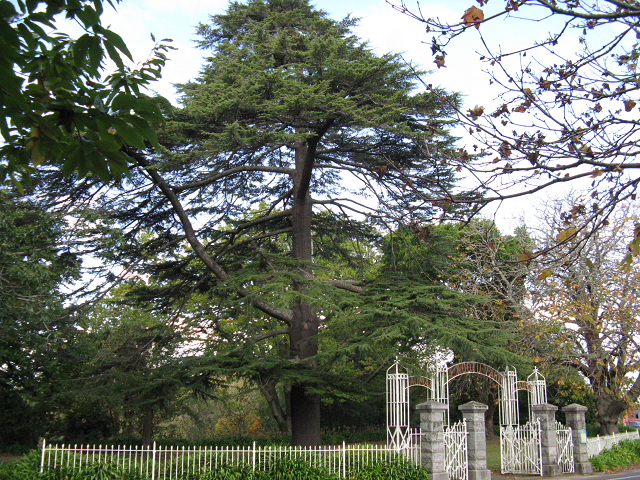Notable trees
Urban Planting in a Warming Climate – long-term planning

The Tree Trust is currently working with the Waipa District Council arborist, James Richardson, to grow oaks that will be able to withstand the hotter and often drier summers that we are likely to experience in the next 100 years and beyond. Many of our favourite oaks in Cambridge prefer cooler climes, such as the English oak (Quercus robur) and some of the North American ones like northern red oak (Q. rubra). As the average temperature rises these species may begin to suffer stress.
From the oak arboretum across the road from Cambridge High School, James has collected acorns from a number of species that originate in warmer parts of the world. Germinated last spring, many have grown extremely well and it is hoped that some will be ready to plant as early as 2026. Species include several from the USA such as Q. falcata (southern red oak), acutissima (saw tooth oak), macrocarpa (bur oak), and also Q. canariensis (Algerian oak), variabilis (Chinese cork bark oak – see photo), faginea (Portuguese oak), affinis (Mexican evergreen oak).
Of course, many of the trees that are already common in our parks and streets will probably survive including most of the eucalypts, liquidambers, evergreen and claret ashes, the oriental plane, the Taiwanese cherry. Unfortunately many of the cultivars of the Japanese maple (Acer palmatum) will not enjoy the increasing heat, although the nuggety little trident maple (A. buergerianum) should be okay. Amongst our native trees expect to see those tough-as-old-boots species, totara and kanuka, come to the fore, along with species more often associated with the north – pohutukawa and puriri (kererū will love that).
 ri
ri
Dacrydium cupressinum is a rare treasure in the urban landscape, although there is a small grove of young rimu planted by the Tree Trust in the Green Belt near MacLean St. In the forest, mature rimu trees tower over the canopy, sometimes living for 1 000 years and reaching 50 metres in height.
Along with kahikatea, totara, matai and miro, rimu is a member of the podocarp family, but it is the only New Zealand member of the genus dacrydium, which is found across the Pacific and East Asia.
The old Pakeha name for rimu was red pine as the wood, gum and sap of the tree all have a deep red colour. Maori attributed this to the blood of Tunaroa, the giant eel god slain by Maui, and they valued the wood for making tools, waka and weapons such as spears. The missionary William Colenso noted that rimu were used as "fire trees"; a large hollow tree was set alight inside, the fire slowly burning up the living tree and providing a constant source of fire for the local Maori.
Pakeha found that rimu provided very fine building wood for houses and furniture, especially in those areas from the Waikato southwards where there was no kauri. Due to extensive logging, its range and use are restricted today. Robert Vennell records that the red colouring would stain the hands of the sawmillers, so only the lowest-paid workers were assigned to mill it. At the local Saturday night dances, these men then found it hard to get partners as their stained hands marked them out as poorer workers. Some mills solved this problem by working only kahikatea (white pine) the day before the dance.
Otherwise known as bitternut hickory, it is one of the tallest and most vigorous of the hickory genus, and can reach over 35 metres. Bitternut is usually found in moist mountain valleys, along stream banks and in swamps, but it can also endure dry sites and poor soils. It can be distinguished from other hickories by its bright sulphur-yellow winter buds.
Although closely related to the pecan, the bitternut, as its name suggests, has an inedible nut; not poisonous but so unpleasant to taste that even squirrels avoid them. However, when cooked, the nuts can produce a pleasant milk or tea.
As part of the juglans family, hickories are also related to the walnut, but are taller and more graceful trees. While hickories are almost unknown in Europe, they are characteristic of the vast forests of eastern North America. Here, the bitternut is the most common and widespread of the genus, reaching from Texas and Florida to Maine and Minnesota, and even into southern Ontario and Quebec. Its gorgeous leaves form part of the spectacular Fall display.
Bitternut is often used for lumber and pulpwood. The wood is hard, durable and shock absorbing, and therefore useful for furniture, panelling , ladders and tool handles. Native Americans used bitternut for making bows. Hickory is also used for making floors, being considerably harder than even white oak. Its disadvantage is that the density of the wood makes installing and finishing well, a challenge.
Cambridge Tree Trust will be planting some bitternuts in the new Cambridge dog park on Thornton Road. Because they grow enormous tap roots, they need to be planted when very small.

Kahikatea (Dacrycarpus dacrydioides)
This 20 year-old stand of kahikatea was planted by the Tree Trust near the corner of Maclean and Taylor Streets. Kahikatea prefers wet swampy ground where it eventually grows large buttress roots entwined with those of adjacent trees, a sort of neighbourhood support group. In days gone by kahikatea dominated the swampy lowlands, pure stands covering much of the Waikato. Unfortunately, these forests lay in the path of European settlement and farming and were almost obliterated by burning and milling, although small scattered remnants can still be seen between Cambridge and Te Awamutu.
James Cook and his crew first encountered kahikatea, when paddling up the Waihou River. He noted in his diary that their tall straight trunks would make excellent spars for ships. Shortly thereafter Britain became engaged in naval wars with revolutionary America and France, and the demand for timber brought European vessels to Thames, where for a time Maori helped cut and load timber in exchange for iron tools. However the trade was short-lived because it was found that the logs rotted easily in water.
Had Europeans asked local Maori they might have saved themselves some bother. It was known that kahikatea was unsuitable for waka, but the resinous heartwood that remained after the sapwood had rotted away had other uses for Maori. Tied in bundles it made great fire torches, and blue and black dyes could be extracted and mixed with oils for tattooing. Also, because the timber was hard and did not crack, it was used to make eel spears, fine-toothed combs, gardening tools and musical instruments. In time Europeans too found uses for the pale, odourless wood, most notably to make boxes for the export of butter and cheese.
Ti Kouka, Cordyline Australis.
There are 5 species of cabbage tree native to New Zealand, of which this is the most common. Once said to be the largest lily in the world, ti kouka has now been reclassified as one of the largest agaves, and thus a member of the asparagus family. Normally used in re-vegetation projects in New Zealand, in Britain it is planted in gardens large and small, often standing sentinel beside entrances and staircases, valued both for its exotic appearance and ability to withstand cold.
In Maori culture, the trees were highly revered, being seen as nearly immortal; when cut down, new buds will sprout from the corky bark. It was said that the trees were brought to Aotearoa from Hawaiiki and then planted around places of settlementwhere they marked paths, boundaries and urupa.
They were also a vital source of food for pre-European Maori, providing one of th emain sources of starchy, carbohydrate-rich foods. This was especially important in colder parts of the country where it was difficult to grow kumara. The clusters of undeveloped leaves, somewhat similar to an artichoke heartand known as koata, was helpful in digesting the rich fats from titi (muttonbird) and kereru. Even more important was the long, fructose-rich tap root, kauru. When harvested from small trees before flowering, they could be chewed like sugarcane, but the large ones were cooked en masse in huge umu. Taking a whole day to cook, the surplus could then be stored for the winter or carried as food for travellers and war parties.
The Meaning of Trees, Robert Venell.

Tī kōuka/cabbage tree Cordyline australis 2
Recently I wrote about the food value of the cabbage tree to Māori. This month we look at its value for weaving. Its stiff, robust leaves are a thorough nuisance when tangled in the lawn mower, but they provide some of the finest weaving materials in the country and are an excellent alternative to flax (Phormium tenax). Because the fibres do not shrink in water, they were often used by Māori to make fishing nets and ropes to anchor waka.
They were also woven into sandals (pāraerae), which could be made in different styles according to need. In rough terrain soft plants such as moss were incorporated to provide cushioning for the feet, whereas in grassy country or where there were spikey plants such as speargrass (Aciphylla horrida!) sandals were woven knee high to protect the legs. To help wade through heavy snow small woven mats were attached. Of course these pāraerae would wear out in a few days on rocky terrain, so when travelling long distances Māori would carry many pairs so they could be replaced when necessary.
The mountain cabbage tree or tōī (Cordyline indivisa), has a much broader leaf and is the best species for weaving rain capes. For extra waterproofing an additional under layer of overlapping leaves was used, somewhat like a thatch in reverse. A fine example of such a kahu tōī can be seen in the Auckland War Memorial Museum. Thus equipped with cape and sandals, and carrying a supply of cooked cabbage tree root, Ngāi Tahu were able to hike the routes through the Southern Alps to collect greenstone. (The Meaning of Trees, Robert Vennell)
Cedar of Lebanon (cedrus libani)2
Six years ago I pondered whether this 100 year old tree near the gates to Te Koo utu would survive the construction of the new roundabout. Thankfully it is still there, so time for an update.
‘Around the World in 80 Trees’ tells me that this tree played a ‘critical role in the development of civilization’. Its native range is now confined to isolated mountains of Lebanon, Syria and southern Turkey, but vast cedar forests once stretched across the Eastern Mediterranean to southwestern Iran. And cedar had everything going for it, which is probably the reason for its downfall. Tolerant of both summer drought and winter freezing, its wood was a valuable commodity, used for building the palaces and temples of Assyria, Persia and Babylon, and the trading ships of the Phoenicians. The ancient Egyptians used its resin for embalming the Pharaohs before their burial in the pyramids.
Over-exploitation of cedar is already evident in the 4000 year old Sumerian ‘Epic of Gilgamesh’. Conservation efforts were made including in AD 118 the creation of an imperial cedar forest by the Roman emperor Hadrian. Perversely, it now seems that global warming may help reverse its decline; a recent search for a forest species which will thrive in central Europe in coming centuries shows that Cedrus libani may fit the bill.
Apparently planted as a seed by a soldier returning from the Middle East after World War 1, this tree deserves our respect, and given a chance it may live another 2000 years!

The Cambridge Tree Trust was registered with the Charities Commission as a Charitable Entity under the Charities Act 2005 on 16 August 2007. Registration No: CC10859

